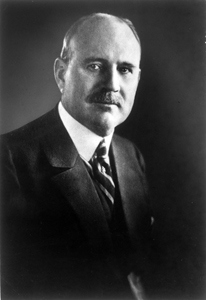
Charles W. Nash - January 28, 1864 - June 6, 1948
An American automobile entrepreneur who served as an executive in the automotive industry. He played a major role in building up General Motors as its 5th President. In 1916, he bought Thomas B. Jeffery Company and later renamed it Nash Motors
Early Years:
Nash was born to a poor farming family in Cortland, Illinois, on what is now Route 38 — Lincoln Highway. Charles’ parents separated when he was six years old and abandoned him. As a result of a court order, he worked as a farmhand in Michigan as an indentured servant under an agreement that was to last until he was 21. At age 12, Nash ran away and became a farmhand on several other farms in Michigan. Later yet, he formed the “Adams & Nash” concern to press hay. While pressing hay on the Halleck farm, he met his future wife, Jessie Halleck, and married her on April 23, 1884. Some time later they moved to Flint, Michigan and in 1890 was hired by William C. Durant of the Flint Road Cart Company, which later become the Durant-Dort Carriage Company.
Durant hired Nash in 1890 for $1 per day as an upholstery stuffer. Within six months, he was promoted to superintendent of the factory. Within 10 years, Nash became vice president and general manager of the Durant-Dort Carriage Company. Nash introduced the straight-line belt conveyor into the assembly of carriages. By 1910, the chief business of Durant-Dort Carriage Company was building automobile bodies for the Buick’s unit of General Motors. (GM was founded in 1908 by Durant, who had bought Buick in 1904.) Around this time, Durant brought Nash to Buick to oversee production. Nash was appointed vice-president of Buick on 13 December 1910. In 1912 Nash was searching for an expert in day-to-day manufacturing operations so he could focus more on sales, supplier relations, and logistics. Nash hired Walter P. Chrysler from the American Locomotive Company to be Buick’s works manager.
In late 1912, Durant was fired by the General Motors board and on November 19, Nash was elected as the fifth president of GM. Under Nash’s leadership, General Motors made immense gains in profits earned and in the number of vehicles produced. However, Nash was reluctant to pay dividends to shareholders and by late 1915 and early 1916, Billy Durant was to reassert his control of GM, and Nash was caught in the power struggle between Durant and bankers. By May 1916, Durant regained control of GM and he supposedly offers Nash a $1 million annual salary to remain with the company. Nash turns Durant down and resigned on June 1st, 1916.
Nash Motors
After his clash with Durant, Nash resolved never again to work for someone else. Along with former GM executives, James J. Storrow and Walter P. Chrysler, Nash attempted to take over Packard, however his effort fails.
Nash learned that Jeffery Motor Company might be for sale. Best known for its Rambler brand of cars, Nash bought the automaker in August of 1916 with a down payment check of half-million dollars and the total deal worth $5 million. In 1917, he renamed the company Nash Motors. Nash was able to negotiate procurement contracts with the United States Army during World War I that made the company one of the largest producers of trucks in the nation. In 1918, Nash was appointed to take charge of engineering and production of aircraft matters for the war effort. In addition to running his own company, Charles Nash also served as president of the luxury automaker LaFayette Motors until Nash Motors bought out the company in 1924.
Nash was best known for producing high-quality automobile for the upper-medium price range and then later adding a smaller, less expensive model, the Ajax. Nash was a hands-on executive, he realized he could never compete with the Big Three, so he based his profits on careful management, close attention to costs, efficient purchasing, and good accounting procedures.
Retirement:
Nash gave up the presidency in 1932, but remained board chairman. Nash wanted George W. Mason as his executive vice president and to have Mason he had to buy Kelvinator a leading manufacturer of refrigerators. After twenty years of success in running his company, Nash turned it over in 1937 and the merged company was renamed Nash-Kelvinator. He died in 1948 at the age of 84 in Beverly Hills, California.
